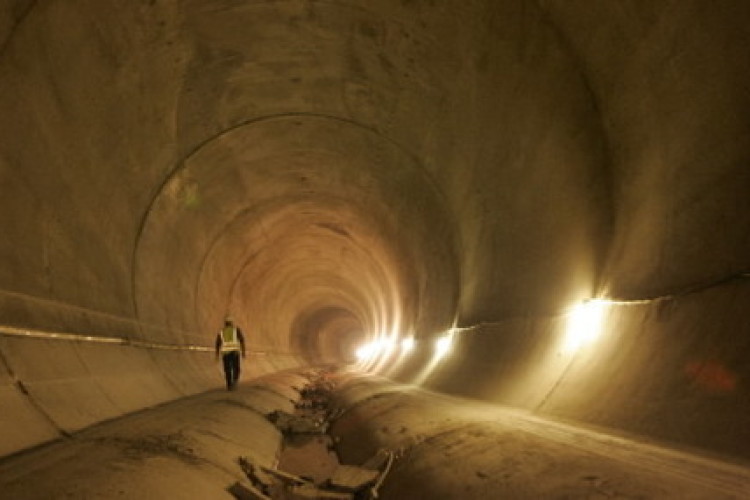The public spending watchdog published a report today, Planning for economic infrastructure, that sets out five risks to achieving value for money and outlines some very basic recommendations on how these might be mitigated. For example, it recommends that all assumptions in forecasts should be tested.
The government expects £310bn to be spent by 2015 and beyond on new infrastructure projects, predominantly in the energy sector (£176bn).
With two-thirds of the money coming from the private sector, the burden of infrastructure funding is shifting from the public as taxpayers to the public as consumers.
The NAO says that the first of the risks to achieving value for money is poor demand forecasting. Secondly, uncertainty over government policy might lead project sponsors, lenders and contractors to defer or abandon projects in the UK for opportunities elsewhere.
Thirdly, the NAO says, there is the possibility of a failure to take into account the cumulative impact on consumers of funding those infrastructure projects where the costs are recovered by charging users. Increasing the burden on consumers may increase the risk of financial hardship, or the need for unplanned taxpayer support. The full impact of spending on economic infrastructure in the years ahead is unclear. While there is information on individual sectors, no overall assessment has been undertaken by government.
Taxpayers may be exposed to substantial losses as a result of government guarantees to bear some project risks (such as cost overruns) should they materialise. The government has taken steps to attract new sources of finance. One of these steps has been its offer to give guarantees to attract construction finance which, while it may help to source new finance, may also expose government to increased financing risk. The Treasury is seeking to address the final risk, that delivery costs might turn out to be higher than they should be, with a cost reduction programme aimed at reducing costs by 15%.
The NAO has made a series of recommendations (below) to help ensure value for money is achieved. It calls for the Treasury to work with departments and regulators to provide greater clarity for consumers regarding the financial impact of planned infrastructure investment. Where there are limits on affordability and availability of finance, the NAO says that the Treasury and departments may need to refine their prioritization of infrastructure programmes and projects.
NAO head Amyas Morse said: "Economic infrastructure keeps the country running. Demand for infrastructure is set to increase, fuelled by population growth, technological progress, climate change and congestion. But there is a lot at stake in taking forward the national infrastructure plan in an environment of straitened resources, with real risks to value for money and uncertainty about the sustainability of piling costs on to consumers.
"I have made a number of recommendations which look to the Treasury, departments and regulators to provide greater clarity on the costs which taxpayers and consumers will bear. Work is already in hand to drive down the costs of delivering new infrastructure and this should continue."
The CBI welcomed the report, with director for business environment Rhian Kelly saying: “Investing in rail, roads, energy, waste and digital infrastructure is a no-brainer. It creates thousands of construction jobs in the short term and generates growth in the long-run. With government spending severely squeezed, the private sector must step up to fill the gap.
“The NAO is right to call for greater clarity to taxpayer and consumers but the CBI wants the government to do much more to give investors certainty and confidence - to attract finance and drive down project costs. Our creaking infrastructure still lags behind other countries and we cannot afford further delays in getting spades in the ground.”
The five key risks to value for money
• Inaccurate identification of the need for infrastructure. For example forecasters may overestimate demand, in which case benefits are lower than expected and poor value for money results.

• Policy uncertainty. This could result in project sponsors, lenders and contractors deferring or abandoning UK projects in favour of opportunities elsewhere. Financing charges for projects may rise as investors and lenders perceive policy uncertainty as a risk.
• Failure to assess the cumulative impact on consumers of funding infrastructure through user charges. This increases the risk of financial hardship for consumers, or the need for unplanned taxpayer support. This is an issue which the National Audit Office will return to in examining how departments and regulators deploy their resources to secure consumer interests.
• Taxpayer exposure to losses. This will happen if the government guarantees to bear or share project risks – for example cost overruns – and that risk subsequently materialises.
• Delivery costs are higher than they should be. UK infrastructure costs have historically been higher than overseas. This could result in high costs for taxpayers and consumers and fewer projects going ahead than planned.
The NAO’s recommendations
The government needs to develop the National Infrastructure Plan and its market support mechanisms to give greater confidence in the flow of viable investment. Without greater certainty on the flow of significant investment opportunities and the likely returns, investors may defer decisions to invest in potential UK projects, or invest elsewhere.
Departments should subject their demand forecasts underpinning infrastructure plans to rigorous testing of sensitivity to alternative realistic assumptions. Future project appraisal needs to consider changes in departments’ assumptions about economic growth and its impact on demand.
The Treasury should work with departments and regulators to provide greater clarity for consumers of the financial impact of planned infrastructure investment. Consumers need information on future costs when managing their finances. Greater certainty and data on the total costs they will bear from infrastructure investment will help consumers. It will also help the Treasury to highlight any risk that the cumulative burden on consumers may become unsustainable.
Government guarantees to attract private finance must give financiers strong disincentives to call upon those guarantees. Guarantees should be:
- based on realistic assessments of risk at the outset;
- structured to align investor and taxpayer interests as far as possible; and
- accompanied by effective monitoring of the underlying risks as the project progresses.
The Treasury and departments may need to refine their prioritisation of infrastructure programmes and projects. Limits on affordability and availability of finance may mean government must either act to address those constraints or target its efforts more narrowly on projects of the highest priority. The Treasury’s monitoring of the National Infrastructure Plan should identify any particular constraints on overall affordability and financeability that may require action.
The Treasury, departments and regulators should work with private sector project sponsors to develop and use ‘should cost’ models, to test or challenge planned infrastructure costs. These bodies should better understand the components of infrastructure costs and how they vary between the UK and other countries. This will help drive down the costs of UK infrastructure.
The Treasury and departments should monitor the effectiveness of their various cost reduction efforts to establish what works best. Our previous work has found that departments have no consistent way of identifying whether specific savings measures have improved efficiency, and do not consistently adopt good practice in taking a structured approach to cost reduction. It will be important to focus on work strands which most effectively reduce costs.
Got a story? Email news@theconstructionindex.co.uk



